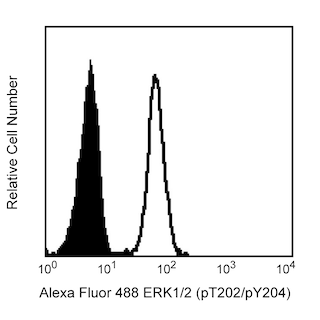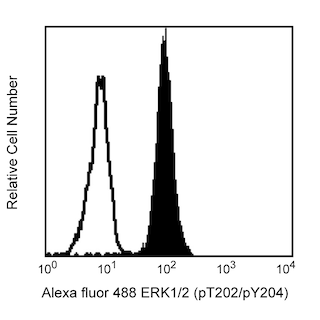Old Browser
This page has been recently translated and is available in French now.
Looks like you're visiting us from {countryName}.
Would you like to stay on the current country site or be switched to your country?




.png)

Analysis of IRAK4 in human peripheral blood lymphocytes (left panel). Human peripheral blood mononuclear cells (PBMC) were lysed and fixed with 1X BD Phosflow™ Lyse/Fix Buffer (Cat. No. 558049) for 10 minutes at 37ºC, then permeabilized (BD Phosflow™ Perm Buffer III, Cat. No. 558050) on ice for 30 minutes, and then stained with either PE Mouse IgG1, κ Isotype Control (Cat. No. 559320, shaded histogram) or PE Mouse anti-Human IRAK4 (Cat. No. 560303, open histogram). For data analysis, lymphocytes were selected by scatter profile. Analysis of IRAK4 in human epithelioid carcinoma (right panel). HeLa S3 cells (ATCC CCL 2.2) were either transfected with IRAK4 RNAi (open histogram) or untreated (shaded histogram). The cells were fixed (BD Cytofix™ buffer, Cat. No. 554655) for 10 minutes at 37°C, then permeabilized (BD Phosflow™ Perm Buffer III, Cat. No. 558050) on ice for 30 minutes, and then stained with PE Mouse anti-Human IRAK4. Flow cytometry was performed on a BD FACSCalibur™ flow cytometry system.

Confirmation of the specificity of mAb L29-525 by western blot analysis (left panel). Lysates of human PBMC were probed with unconjugated antibody at a concentration of 0.1 µg/ml. IRAK4 is identified as a band of about 52 kDa. Western blot validation of IRAK4 by RNAi (right panel). Lysates from HeLa S3 cells (lane 1) and IRAK4 RNAi-transfected HeLa S3 cells (lane 2) were probed with unconjugated mAb L29-525 at 0.015 µg/ml. Down-regulation of IRAK4 expression is evident in the RNAi-transfected cells.
.png)

BD Pharmingen™ PE Mouse anti-Human IRAK4

BD Pharmingen™ PE Mouse anti-Human IRAK4
.png)
Regulatory Status Legend
Any use of products other than the permitted use without the express written authorization of Becton, Dickinson and Company is strictly prohibited.
Preparation And Storage
Recommended Assay Procedures
This antibody conjugate is suitable for intracellular staining of human peripheral blood mononuclear cells and cell lines (using BD Phosflow™ Lyse/Fix Buffer or BD Cytofix™ Fixation Buffer), but not human whole blood. BD Phosflow™ Perm Buffer II or Perm Buffer III may be used.
Product Notices
- This reagent has been pre-diluted for use at the recommended Volume per Test. We typically use 1 × 10^6 cells in a 100-µl experimental sample (a test).
- An isotype control should be used at the same concentration as the antibody of interest.
- Source of all serum proteins is from USDA inspected abattoirs located in the United States.
- Caution: Sodium azide yields highly toxic hydrazoic acid under acidic conditions. Dilute azide compounds in running water before discarding to avoid accumulation of potentially explosive deposits in plumbing.
- For fluorochrome spectra and suitable instrument settings, please refer to our Multicolor Flow Cytometry web page at www.bdbiosciences.com/colors.
- Please refer to www.bdbiosciences.com/us/s/resources for technical protocols.
Companion Products






Interleukin 1 (IL-1) is a proinflammatory cytokine that mediates the host inflammatory response. IL-1 exerts its biological effects through its type I receptor (IL-1RI), which is found on most cell types. When IL-1 binds to the IL-1RI, NF-κB (transcription factor) is activated and translocates to the nucleus where it induces gene expression. IL-1-receptor-associated kinase (IRAK) has been reported to co-immunoprecipitate with IL-1RI. The IRAK family is made up of four identified Pelle homologs that regulate the activation of NF-κB and mitogen-activated protein (MAP) kinase pathways. IRAK4 is a unique member of the IRAK family because it is the closest mammalian homolog to Pelle. Also, when overexpressed, its kinase activity allows it to activate both the NF-κB and mitogen-activated protein (MAP) kinase pathways, and block the IL-1-induced activation and modification of IRAK1. IRAK4 is also able to phosphorylate IRAK1, which suggests that IRAK4 affects the early signal transduction of Toll/IL-1 receptors before the involvement of IRAK1.
The L29-525 monoclonal antibody recognizes human IRAK4, regardless of phosphorylation status. The specificity of this antibody conjugate for flow cytometric analysis was validated by confirming that RNA-mediated interference (RNAi) of the specific protein reduced the staining of the cells (see figure). Furthermore, the capacity of the RNAi to down-regulate the expression of the relevant protein was confirmed by western blot analysis.

Development References (4)
-
Hatao F, Muroi M, Hiki N, et al. Prolonged Toll-like receptor stimulation leads to down-regulation of IRAK-4 protein. J Leukoc Biol. 2004; 76(4):904-908. (Biology). View Reference
-
Li S, Strelow A, Fontana EJ, Wesche H. IRAK-4: a novel member of the IRAK family with the properties of an IRAK-kinase. Proc Natl Acad Sci U S A. 2002; 99(8):5567-5572. (Biology). View Reference
-
Lye E, Mirtsos C, Suzuki N, Suzuki S, Yeh WC. The role of interleukin 1 receptor-associated kinase-4 (IRAK-4) kinase activity in IRAK-4-mediated signaling. J Biol Chem. 2004; 279(39):40653-40658. (Biology). View Reference
-
Suzuki N, Saito T. IRAK-4 – a shared NF-κB activator in innate and acquired immunity. Trends Immunol. 2006; 27(12):566-572. (Biology). View Reference
Please refer to Support Documents for Quality Certificates
Global - Refer to manufacturer's instructions for use and related User Manuals and Technical data sheets before using this products as described
Comparisons, where applicable, are made against older BD Technology, manual methods or are general performance claims. Comparisons are not made against non-BD technologies, unless otherwise noted.
For Research Use Only. Not for use in diagnostic or therapeutic procedures.
Report a Site Issue
This form is intended to help us improve our website experience. For other support, please visit our Contact Us page.